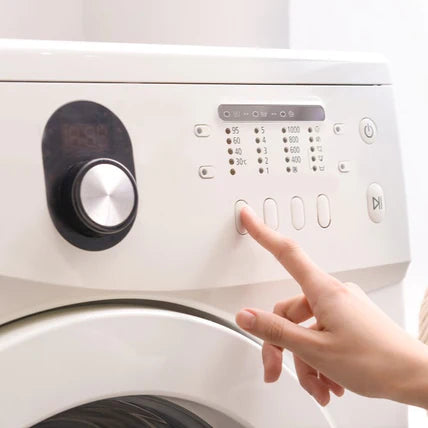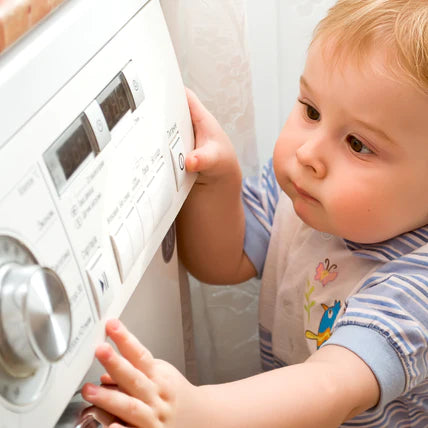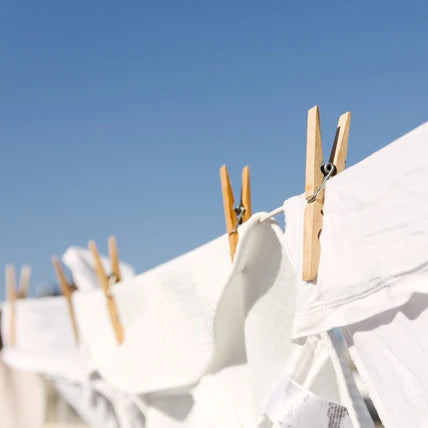How to keep your nappies & accessories looking brand new.
Washing Guidelines
From washing and drying techniques to stain removal and maintenance tips, this guide will help you prolong the life of your cloth nappies and keep them looking brand new.
1. Dry Pail
2. First Wash
3. Main Wash
4. Dry
Once you have finished changing your baby, remove the inserts from the nappy and place them in your dry pail (like pictured above), where they will wait for the prewash.
If your baby is exclusively formula or breast-fed, any waste is water soluble and no additional treatment is necessary. However, if your infant has started eating solid foods, their poo must be emptied into the toilet and rinsed off before being placed in the dry pail.
It is recommended to run a prewash cycle on your cloth nappies every one to two days in the evening or the following morning.
A pre-wash is a shorter cycle on your washing machine intended to remove the initial soiling of your nappy. For optimal results, it is advisable to wash your nappy on a 40-60 degrees , utilising a 30 to 60 minute cycle.
After the prewash cycle, your nappies should undergo a second wash cycle every three to four days, comprising the last three or four days' worth of prewashed nappies that have accumulated.
This is a lengthier cycle, lasting a minimum of two hours, and should be set at a temperature of 40-60 degrees Celsius to guarantee that your nappies are deeply cleaned.
Once your main wash cycle has been completed, your nappies can be hung out to dry. For the extended lifespan of your nappy shells, it is advisable to line dry them in the shade or on a clothes horse beneath a fan.
While shells and inserts may be tumble-dried on low heat, utilising a dryer will speed up the wear and tear of your nappies.




FAQs
How to wash reusable cloth nappies
No need to soak inserts before first time use, pop them in a standard washing cycle with detergent to remove all manufacturing residue before putting them on your baby's bottom.
How often do I need to wash my cloth nappies?
It is recommended for nappies complete a first wash every 1 to 2 days and then complete a second main wash cycle no longer than 4 days later.
So basically, you will find yourself washing and hanging nappies out twice a week at the most.
Does the dry pail smell?
In short, no - and if you do have smells then there might be something wrong with your wash routine (please reach out to us to review this with you).
An open wire basket with lots of airflow will stock excess bacteria build up which is where the smell comes from.
What do I do with the poo?
Nappies of babies under the age of 6 months and not yet eating solid food can be placed directly into your dry pail.
If your child is eating solid food, drop any solid matter into the toilet and lightly rinse.
No need for vigorous scrubbing or soaking, removing the majority will give you an optimal clean.
Can I soak my cloth nappies?
This is no longer required and is essentially just a breeding ground of bacteria.
Soaking nappies is not great for the PUL of the outer nappy or the elastics which are encased within the shell.
Do I need special detergent?
Most mainstream detergents are effective in cleaning cloth nappies, the most popular options include Omo and Biozet.
If you are looking for a more environmentally conscious detergent options, KinKin & Eco Store are great choices but do have better results on a 60-degree cycle.
Can I wash my nappies on cold?
You are going to receive the best results in washing your nappies when warmed on 40-60 degree temperatures. Most front loader washing machines heat their own water so don't require a hot water inlet.
Do I have to run a first wash?
The first wash is designed to remove all initial soiling from a nappy and a main wash (second cycle) will give all your nappies a thorough clean.
It is essential to ensure all soiling has been removed from the nappies, a main wash cycle is completed on freshly clean water.

